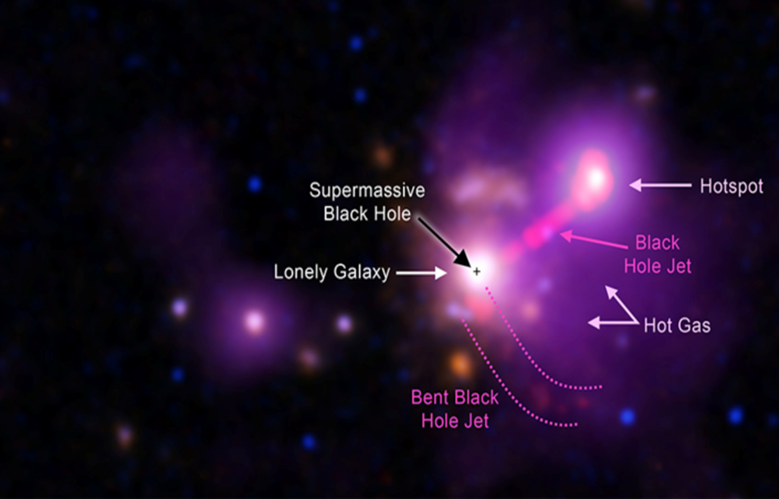A lonely, newly discovered galaxy is isolated because it ate all its friends

April 7, 2023April 7, 2023 3C 297, black hole, galaxy, Hubble Space Telescope, supermassive black hole, Milky Way, x-ray astronomy, quasar, cluster of galaxies, Chandra X-ray Observatory, active galactic nucleus
This image shows a lone galaxy called 3C 297 (bright spot center right), which is much more massive than expected after it has likely pulled away and merged with its neighboring galaxies.
A new study suggests that the distant galaxy is lonely because it has devoured the other galaxies that once surrounded it.
Galaxy 3C 297 floats in the void on its own, about 9.2 billion light-years from Earth, but it wasn't always that way. New observations by NASA's Chandra X-ray Observatory and the International Gemini Observatory reveal that 3C 297 has all the characteristics of a galaxy cluster — except for the other galaxies. These lost galaxies seem to have merged with each other and with 3C 297 which was the largest, lonely remnant.
“We expected to see at least a dozen galaxies the size of the Milky Way, but we only see one,” study leader Valentina Missaglia, of the University of Turin in Italy, said in a statement.

Annotated image of galaxy 3C 297, located about 9.2 billion light-years from Earth. The galaxy is lonelier than expected after it has likely pulled and filled out previous companion galaxies.
3C 297 is now referred to as the "fossil cluster" because it appears to be the final stage of a merger involving multiple galaxies that were once part of a cluster. It is also the most remote fossil group ever discovered. Missaglia and her research team saw that this single body of stars behaved as a group in a number of ways. For example, it is shrouded in clouds of scorching gas measuring tens of millions of magnitudes—not the norm for a lone galaxy, but common for a cluster.
Another sign is the behavior of a quasar that is an active galactic nucleus (AGN). These supermassive black holes eat the dust and gas pulled in by their intense gravity, and then erupt huge jets of fast-moving material. This quasar's jet generated strong emissions of X-rays about 140,000 light-years away, indicating that it interacted with gas surrounding 3C 297 — an indication of the existence of an earlier group of galaxies, study team members said.
But wait. If 3C 297 is so lonely, why does it appear relatively close to 19 other galaxies? This was shown by an image from the Gemini Observatory, but it turned out to be something of an optical illusion, because when the distances of those galaxies from 3C 297 were measured, none were close enough to form a cluster.
There are still interesting unanswered questions about 3C 297. For example, astronomers see the galaxy as it appeared 9.2 billion years ago. This is earlier than any other known fossil group, and it is unclear how the system could have evolved in this way in such a relatively short time frame.
“It may be difficult to explain how the universe could have created this system only 4.6 billion years after the Big Bang,” study co-author Misha Schirmer, from the Max Planck Institute for Astronomy, said in the same statement. "This does not break our ideas of cosmology, but it does begin to push the boundaries on how quickly both galaxies and galaxy clusters form."
The study was published in December 2022 in The Astrophysical Journal.
Source: websites

